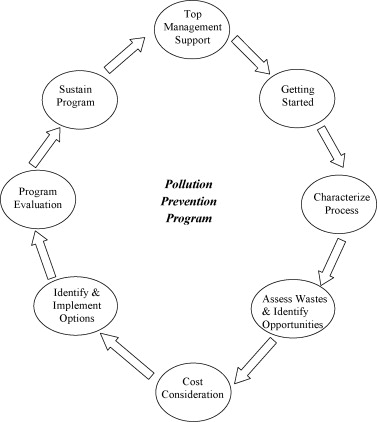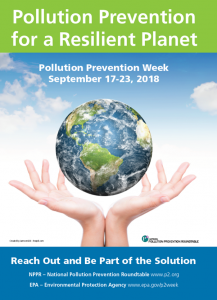Recently, Rick Yoder of P2RIC asked me to help him identify resources that local and county governments can use when developing waste reduction policies. This post compiles our results to provide a starting point for communities looking to do similar projects.
Comprehensive resources and templates
Waste Reduction Planning and Implementation for Owners/Operators (CalRecycle)
A comprehensive web page with linked steps to developing a good waste reduction plan. Lists specific material options and multiple policy suggestions. Concludes with reference to an environmental management system (EMS).
Implementing Waste Reduction (CalRecycle)
Outlines the steps for establishing a waste reduction program within a state agency. Many of these steps are consistent with those used by the private sector. This is a general outline that pertains mostly to office settings.
SFEnvironment: Striving for Zero Waste
Details San Francisco’s steps to become a zero waste city by 2020. Includes links to ordinances and practices that prevent waste, reduce and reuse first, and recycle and compost. They also link to policies related to zero waste.
StopWaste.org Model Policies and Ordinances
Links to models policies and ordinances in Alameda, Calif.
Austin Resource Recovery Master Plan (2011)
The Austin Resource Recovery Master Plan (Master Plan) projects future activities and services provided by Austin Resource Recovery (ARR or Department) for the next 30 years. The Master Plan looks at the Department in its entirety, laying a framework for how the Department provides services to its customers and empowers the Austin community to achieve Zero Waste. Implementation plans for each proposed project, service or policy will be developed within the context of the Master Plan, each one in synergy with the other to ensure consistency between the service message and physical development of the service program.
Texas Pollution Prevention (P2) Planning
Through the Waste Reduction Policy Act (WRPA), Texas requires companies that are large quantity generator or report on TRI Form R to submit P2 reports to the state each year. The site includes information on the state law and associated regulations, as well as a pollution prevention planning guide for facilities and links to P2 planning resources.
Zero Waste Communities (CalRecycle)
Links to Communities with Zero Waste Plans and Resolutions; Communities Educating on Zero Waste or Working Toward a Plan; Zero Waste Community Tools and Resources; and Zero Waste Community Case Studies.
Reducing Waste and Recycling More, An Evaluation of Policies from Across America
Evaluation of extended producer responsibility policies from around the U.S.
General Service Administration (Denver) > Waste Reduction & Recycling
Compilation of GSA Denver waste reduction and recycling policies and regulations.
Sustainable Facilities Tool (GSA)
Brings together the sustainability information necessary to green your buildings. Use SFTool as your quick reference for day-to-day questions or dig deeper to understand more about efficiency, indoor environmental quality, conservation and the connections between them.
Buildings
Circular Economy in the Built Environment: Opportunities for Local Government Leadership
Authored by StopWaste and Arup, this primer provides an overview of a circular economy framework for the built environment at the community, neighborhood and building scales. The ideas and concepts included here are intended to stimulate local government decision-makers and staff in Alameda County and beyond to consider policies and actions in their jurisdictions. It illustrates concepts with real-world examples of sites and policies. The document is intended to initiate conversation and action among public policymakers, public agency staff and other partners.
Food waste
ReFED > State & Local Governments
Links to information about ways that states and municipalities can incentivize prevention, recovery, and recycling of food waste.
Tackling Food Waste, Nashvillian-Style
In 2015, NRDC launched the Nashville Food Waste Initiative (NFWI) to develop high-impact policies, strategies, and practical tools to serve as models for cities around the country. As a midsize, demographically diverse metropolis in the center of the country, Nashville can serve as a model for other cities. This page provides an overview of the project and links to resources.
Nashville Food Rescue Landscape Analysis
Recent research by NRDC explored the potential to expand food rescue from consumer-facing businesses (such as institutional foodservice, restaurants, caterers, convenience stores and retail grocery) located in Nashville, Denver and New York City. The analysis for Nashville found that the equivalent of 9.3 million additional meals could, hypothetically, be rescued from these business sectors per year under optimal conditions. This includes the potential for an additional 2.4 million meals from restaurants, 1.8 million meals from institutions including hospitality (mainly hotels), healthcare, colleges, universities and K-12 and an estimated 200,000 meals from caterers. Much of the potential from these foodservice sectors would likely be in the form of prepared foods. If the potential from institutions, restaurants and caterers could be realized, it would meet an additional 23% of the meal gap in Davidson County. The possibility of expanding donation of high quality prepared food thus resents a significant opportunity in Nashville.
GLRPPR Sector Resources
Journal articles
Contact your local library to obtain the full-text of these articles.
Policy incentives to minimize generation of municipal solid waste (Waste Management Research, 2000)
Municipal solid waste minimization involves decisions by product manufacturers, government institutions, private businesses, and householders to reduce the amount of waste placed in the waste stream (‘source‐reduction’) and to divert waste entering the waste stream toward benign purposes (‘waste diversion’) – rather than toward disposal through incineration or landfilling. Three basic types of policy incentives can be used to prompt waste generators, handlers, and managers to minimize waste generation: command‐and‐control regulations, social‐psychological incentives, and economic incentives. The likelihood of command‐and‐control regulations being successfully implemented depends importantly on the social‐psychological and economic incentives for waste minimization provided in the regulations. Experience from various parts of the world shows that, when such incentives are provided, agencies and individual householders can learn to change their attitudes and behavior toward generation and disposal of waste. However, fully achieving this result will require considerable time and much purposeful attention to the wide array of interrelated matters required in minimizing waste generation.
Effectiveness of state pollution prevention programs and policies (Contemporary Economic Policy, 2013)
States are using regulatory-, information-, and management-based policies to encourage the adoption of pollution prevention (P2) and reduce pollution. Using a sample of facilities of S&P 500 firms which report to the Toxic Releases Inventory from 1991 to 2001, this study employs dynamic panel data models to examine the effectiveness of state legislations and policies in increasing P2 and reducing toxic releases. I find that toxic waste legislations are effective in reducing toxic releases and in promoting P2, but the effect of policy instruments differ. Facilities in states with reporting requirement and mandatory planning adopt more P2 even in states that do not emphasize toxic waste reduction. The effectiveness of reporting is stronger among facilities with good environmental performance, while the potency of mandatory planning is greater among facilities with past P2 experience. In contrast, numerical goals reduce toxic pollution levels only among those which have been subjected to high levels of enforcement action. These suggest that reporting requirement and mandatory planning may be promoting the P2 practices which can improve public image and which benefit from enhanced technical know-how, but they are not causing meaningful pollution reductions, implying that the existing policies must be complemented by other approaches to achieve higher reductions in toxic pollution levels.
Wasteful waste-reducing policies? The impact of waste reduction policy instruments on collection and processing costs of municipal solid waste (Waste Management, 2011)
We study the impact of some local policies aimed at municipal solid waste (MSW) reduction on the cost efficiency of MSW collection and disposal. We explicitly account for differences between municipalities in background conditions by using a bootstrapped version of the Data Envelopment Analysis methodology in combination with a matching technique. Using data on 299 municipalities in Flanders, Belgium, for the year 2003, our results indicate that municipalities that are member of a waste collection joint venture, or that subscribe to a voluntary agreement to reduce MSW at the highest ambition level, collect and process MSW more efficiently than other municipalities. Weekly instead of two-weekly waste collection, or using a weight-based pricing system appears to have no impact on efficiency. Our results show that aiming at MSW reduction does not lead to lower efficiency of public service provision, even on the contrary.
Direct and indirect effects of waste management policies on household waste behaviour: The case of Sweden (Waste Management, 2018)
Swedish legislation makes municipalities responsible for recycling or disposing of household waste. Municipalities therefore play an important role in achieving Sweden’s increased levels of ambition in the waste management area and in achieving the goal of a more circular economy. This paper studies how two municipal policy instruments – weight-based waste tariffs and special systems for the collection of food waste – affect the collected volumes of different types of waste. We find that a system of collecting food waste separately is more effective overall than imposing weight-based waste tariffs in respect not only of reducing the amounts of waste destined for incineration, but also of increasing materials recycling and biological recovery, despite the fact that the direct incentive effects of these two systems should be similar. Separate food waste collection was associated with increased recycling not only of food waste but also of other waste. Introducing separate food waste collection indirectly signals to households that recycling is important and desirable, and our results suggest that this signalling effect may be as important as direct incentive effects.
Waste policies gone soft: An analysis of European and Swedish waste prevention plans (Waste Management, 2018)
This paper presents an analysis of European and Swedish national and municipal waste prevention plans to determine their capability of preventing the generation of waste. An analysis of the stated objectives in these waste prevention plans and the measures they propose to realize them exposes six problematic features: (1) These plans ignore what drives waste generation, such as consumption, and (2) rely as much on conventional waste management goals as they do on goals with the aim of preventing the generation of waste at the source. The Swedish national and local plans (3) focus on small waste streams, such as food waste, rather than large ones, such as industrial and commercial waste. Suggested waste prevention measures at all levels are (4) soft rather than constraining, for example, these plans focus on information campaigns rather than taxes and bans, and (5) not clearly connected to incentives and consequences for the actors involved. The responsibility for waste prevention has been (6) entrusted to non-governmental actors in the market such as companies that are then free to define which proposals suit them best rather than their being guided by planners. For improved waste prevention regulation, two strategies are proposed. First, focus primarily not on household-related waste, but on consumption and production of products with high environmental impact and toxicity as waste. Second, remove waste prevention from the waste hierarchy to make clear that, by definition, waste prevention is not about the management of waste.
Waste management regulation: policy solutions and policy shortcomings (Scottish Journal of Political Economy, 2018)
A model of packaging waste management is presented to explore the policy options available to governments to implement waste regulation in light of the Extended Producer Responsibility (EPR). Our model endogenizes the packaging design as an additional determinant for the overall amount of waste jointly with consumers’ sorting effort and producers’ output decisions. The model shows that the policies that yield the first‐best allocation may not find public support. Furthermore, if the set of available policy instruments is limited, production and consumption of the good is likely to settle on a sub‐optimal level even though the optimal allocation may be achievable. Finally, the model demonstrates that a landfill tax may actually increase landfill waste in the presence of tradable credits for recycling activities. The results shed light on some shortcomings of existing regulatory schemes such as the Producer Responsibility Obligations (Packaging Waste) Regulations of the UK.
Food Policies to Tackle Food Waste: A Classification (in Food Waste at the Consumer Level: A Comprehensive Literature Review, 2018)
Food waste definitely represents a threat for the sustainability of our food systems. Recently governments are starting to be aware of it and are implementing promising food policies. Indeed, in this chapter we will seek to highlight the most relevant international policies put forward to curb the phenomenon and to classify them, according to the most effective food policy measures.
Food waste matters – A systematic review of household food waste practices and their policy implications (Journal of Cleaner Production, 2018)
In recent years, food waste has received growing interest from local, national and European policymakers, international organisations, NGOs as well as academics from various disciplinary fields. Increasing concerns about food security and environmental impacts, such as resource depletion and greenhouse gas emissions attributed to food waste, have intensified attention to the topic. While food waste occurs in all stages of the food supply chain, private households have been identified as key actors in food waste generation. However, the evidence on why food waste occurs remains scattered. This paper maps the still small but expanding academic territory of consumer food waste by systematically reviewing empirical studies on food waste practices as well as distilling factors that foster and impede the generation of food waste on the household level. Moreover, we briefly discuss the contributions of different social ontologies, more particularly psychology-related approaches and social practice theory. The analysis reveals food waste as a complex and multi-faceted issue that cannot be attributed to single variables; this also calls for a stronger integration of different disciplinary perspectives. Mapping the determinants of waste generation deepens the understanding of household practices and helps design food waste prevention strategies. Finally, we link the identified factors with a set of policy, business, and retailer options.



 In 1990, Congress passed the Pollution Prevention Act. Pollution Prevention (P2) Week, celebrated during the third week of September each year (September 17-23, 2018), highlights the efforts of EPA, its state partners, industry, and the public in preventing pollution right from the start.
In 1990, Congress passed the Pollution Prevention Act. Pollution Prevention (P2) Week, celebrated during the third week of September each year (September 17-23, 2018), highlights the efforts of EPA, its state partners, industry, and the public in preventing pollution right from the start.